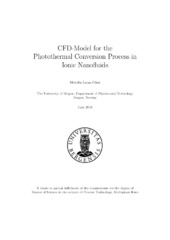CFD-Model for the Photothermal Conversion Process in Ionic Nanofluids
Abstract
Harnessing energy from a sustainable source like the Sun may be one of the key solutions for the increasing demand of energy. However, conventional solar harvesters are relatively low efficient so that use of solar energy is challenging. Several experimental studies have shown in the last decades that the optical and thermophysical properties of the working fluid in solar collectors can be enhanced by adding nano-sized particles. These findings have led to the development of the Direct Absorption Collector (DAC), which is a more promising device compared to the most widely used solar collector, i.e. the flat plate collector. However, a reliable theoretical description of the process phenomena is required for the optimization of the design. In this research, photothermal energy conversion in nanofluids was numerically studied using a Computational Fluid Dynamics (CFD) model. A DAC of cylindrical shape with incident light on one of its surfaces was adopted for simulations. The Eulerian two-phase transient model included the volumetric absorption of light, losses to the surroundings and the Brownian motion. The validation of the model with experimental data demonstrated low discrepancies. The model was studied parametrically, altering the extinction coefficient and specific heat of the base fluid, as well as the surface transparency, collector height, solar concentration, particle volume fraction and particle size. The enhancement in efficiency (20%) due to the use of nanofluids was demonstrated by comparison against a selective surface absorption collector. The radiative and convective losses from the DAC surfaces were increased with the nanoparticle volume fraction and with the solar concentration. As the collector height was reduced, the maximum average temperature increased. A maximum temperature of 200.8°C was observed for a 1 cm nanofluid column and 10 sun, where 1 sun equals 1000 W m^(-2). For a 1 cm solar collector and 2.3 sun, a maximum thermal receiver efficiency of 67% was found for 50 ppm. Increasing the particle size did not lead to a significant enhancement in the receiver efficiency. Nevertheless, it resulted in significant particle deposition. A strong dependency on the size of the nanofluid column and convection currents was shown. The efficiency was enhanced by 14.5% for the case when the incident light was to the bottom surface in comparison to the case when the incident light irradiated the top surface. The maximum velocity of the dispersed phase was 0.15 cm s^(-1), which was found for the case when particle concentration was 1.25 ppm. Finally, design recommendations were presented based on the performed theoretical analysis.
